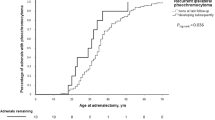Abstract
Background
Bilateral pheochromocytoma (PHEO) is more frequently found in patients with multiple endocrine neoplasia 2A carrying a RET germline mutation located in codon 634 (C634). However, it is unclear whether different amino acid substitutions within C634 cause differences in bilateral PHEOs expression. We aimed to answer this by pooling data from two Asian institutions.
Methods
Sixty-seven patients had confirmed C634 germline mutation. Age-dependent penetrance of bilateral PHEO was calculated from date of birth to the date when bilateral PHEO was first diagnosed or when the contralateral gland became a PHEO (if the patient already had one adrenal gland removed). Age-dependent penetrance was estimated by the Kaplan–Meier method and compared by log-rank test.
Results
The 4 different amino acid substitutions included C634R (arginine) (n = 19, 28.4 %), C634Y (tyrosine) (n = 36, 38.8 %), C634G (glycine) (n = 4, 6.0 %), and C634W (tryptophan) (n = 8, 11.9 %). The age-related penetrance of PHEO was similar between C634R, C634Y, C634G, and C634W (by age 40, 69.8, 55.2, 25.0, and 56.2 %, respectively) (p = 0.529). However, the age-related penetrance of bilateral PHEO in C634R was significantly higher than C634Y (by age of 40, 59.3 % vs. 25.2 %, p = 0.046) or C634Y, C634G, and C634W combined (59.3 % vs. 21.5 %, p = 0.024). Nevertheless, the accumulative risk of bilateral PHEOs across all four C634 mutations almost approached 100 % over time.
Conclusion
The accumulative risk of bilateral PHEOs almost reached 100 % but its onset was significantly earlier in C634R mutation. These findings implied that those with C634R mutation might benefit from earlier screening of contralateral PHEO than other C634 mutations after an unilateral adrenalectomy.




Similar content being viewed by others
References
Asari R, Scheuba C, Kaczirek K, Niederle B (2006) Estimated risk of pheochromocytoma recurrence after adrenal-sparing surgery in patients with multiple endocrine neoplasia type 2A. Arch Surg 141(12):1199–1205 discussion 1205
Machens A, Brauckhoff M, Holzhausen HJ, Thanh PN, Lehnert H, Dralle H (2005) Codon-specific development of pheochromocytoma in multiple endocrine neoplasia type 2. J Clin Endocrinol Metab 90(7):3999–4003
Castinetti F, Qi XP, Walz MK et al (2014) Outcomes of adrenal-sparing surgery or total adrenalectomy in phaeochromocytoma associated with multiple endocrine neoplasia type 2: an international retrospective population-based study. Lancet Oncol 15(6):648–655
Lau GS, Lang BH, Lo CY, Tso A, Garcia-Barcelo MM, Tam PK, Lam KS (2009) Prophylactic thyroidectomy in ethnic Chinese patients with multiple endocrine neoplasia type 2A syndrome after the introduction of genetic testing. Hong Kong Med J 15(5):326–331
Puñales MK, Graf H, Gross JL, Maia AL (2003) RET codon 634 mutations in multiple endocrine neoplasia type 2: variable clinical features and clinical outcome. J Clin Endocrinol Metab 88(6):2644–2649
MEN Consortium of Japan, Imai T, Uchino S, Okamoto T, Suzuki S et al (2013) High penetrance of pheochromocytoma in multiple endocrine neoplasia 2 caused by germ line RET codon 634 mutation in Japanese patients. Eur J Endocrinol 168(5):683–687
Quayle FJ, Fialkowski EA, Benveniste R, Moley JF (2007) Pheochromocytoma penetrance varies by RET mutation in MEN2A. Surgery 142:800–805
Lo CY, Wat NM, Lam KY, Tiu SC, Chan J, Lam KS (2003) Multiple endocrine neoplasia type 2A in Chinese families. Clin Endocrinol (Oxf). 58(4):528
Zhou Y, Zhao Y, Cui B et al (2007) RET proto-oncogene mutations are restricted to codons 634 and 918 in mainland Chinese families with MEN2A and MEN2B. Clin Endocrinol (Oxf) 67(4):570–576
Valdés N, Navarro E, Mesa J, Casterás A, Alcázar V, Lamas C, Tébar J, CastaÑo L, Gaztambide S, Forga Llenas L (2014) RET Cys634Arg mutation confers a more aggressive multiple endocrine neoplasia type 2A phenotype than Cys634Tyr mutation. Eur J Endocrinol 172:301–307
Ku CF, Lo CY, Chan WF, Chiu SW, Fan ST, Lam KS (2005) Resection of phaeochromocytoma extending into the right atrium in a patient with multiple endocrine neoplasia type 2A. Hong Kong Med J 11(1):59–62
Milos IN, Frank-Raue K, Wohllk N et al (2008) Age-related neoplastic risk profiles and penetrance estimations in multiple endocrine neoplasia type 2A caused by germ line RET Cys634Trp (TGC > TGG) mutation. Endocr Relat Cancer 15(4):1035–1041
Eng C, Clayton D, Schuffenecker I et al (1996) The relationship between specific RET proto-oncogene mutations and disease phenotype in multiple endocrine neoplasia type 2. International RET mutation consortium analysis. JAMA 276(19):1575–1579
Yip L, Lee JE, Shapiro SE, Waguespack SG, Sherman SI, Hoff AO, Gagel RF, Arens JF, Evans DB (2004) Surgical management of hereditary pheochromocytoma. J Am Coll Surg 198(4):525–534
Rodriguez JM, Balsalobre M, Ponce JL, Ríos A, Torregrosa NM, Tebar J, Parrilla P (2008) Pheochromocytoma in MEN 2A syndrome. Study of 54 patients. World J Surg 32(11):2520–2526. doi:10.1007/s00268-008-9734-2
Chang RY, Lang BH, Wong KP, Lo CY (2014) High pre-operative urinary norepinephrine is an independent determinant of peri-operative hemodynamic instability in unilateral pheochromocytoma/paraganglioma removal. World J Surg 38(9):2317–2323. doi:10.1007/s00268-014-2597-9
Thosani S, Ayala-Ramirez M, Palmer L et al (2013) The characterization of pheochromocytoma and its impact on overall survival in multiple endocrine neoplasia type 2. J Clin Endocrinol Metab 98(11):E1813–E1819
Castinetti F, Qi XP, Walz MK et al (2014) Outcomes of adrenal-sparing surgery or total adrenalectomy in phaeochromocytoma associated with multiple endocrine neoplasia type 2: an international retrospective population-based study. Lancet Oncol 5(6):648–655
Siqueira DR, Ceolin L, Ferreira CV, Romitti M, Maia SC, Maciel LM, Maia AL (2014) Role of RET genetic variants in MEN2-associated pheochromocytoma. Eur J Endocrinol 170(6):821–828
Author information
Authors and Affiliations
Corresponding author
Additional information
Brian Hung-Hin Lang and Hyeong Won Yu are co-first authors of this article.
Rights and permissions
About this article
Cite this article
Lang, B.HH., Yu, H.W., Lo, CY. et al. Bilateral Pheochromocytomas in MEN2A Syndrome: A Two-Institution Experience. World J Surg 39, 2484–2491 (2015). https://doi.org/10.1007/s00268-015-3117-2
Published:
Issue Date:
DOI: https://doi.org/10.1007/s00268-015-3117-2




